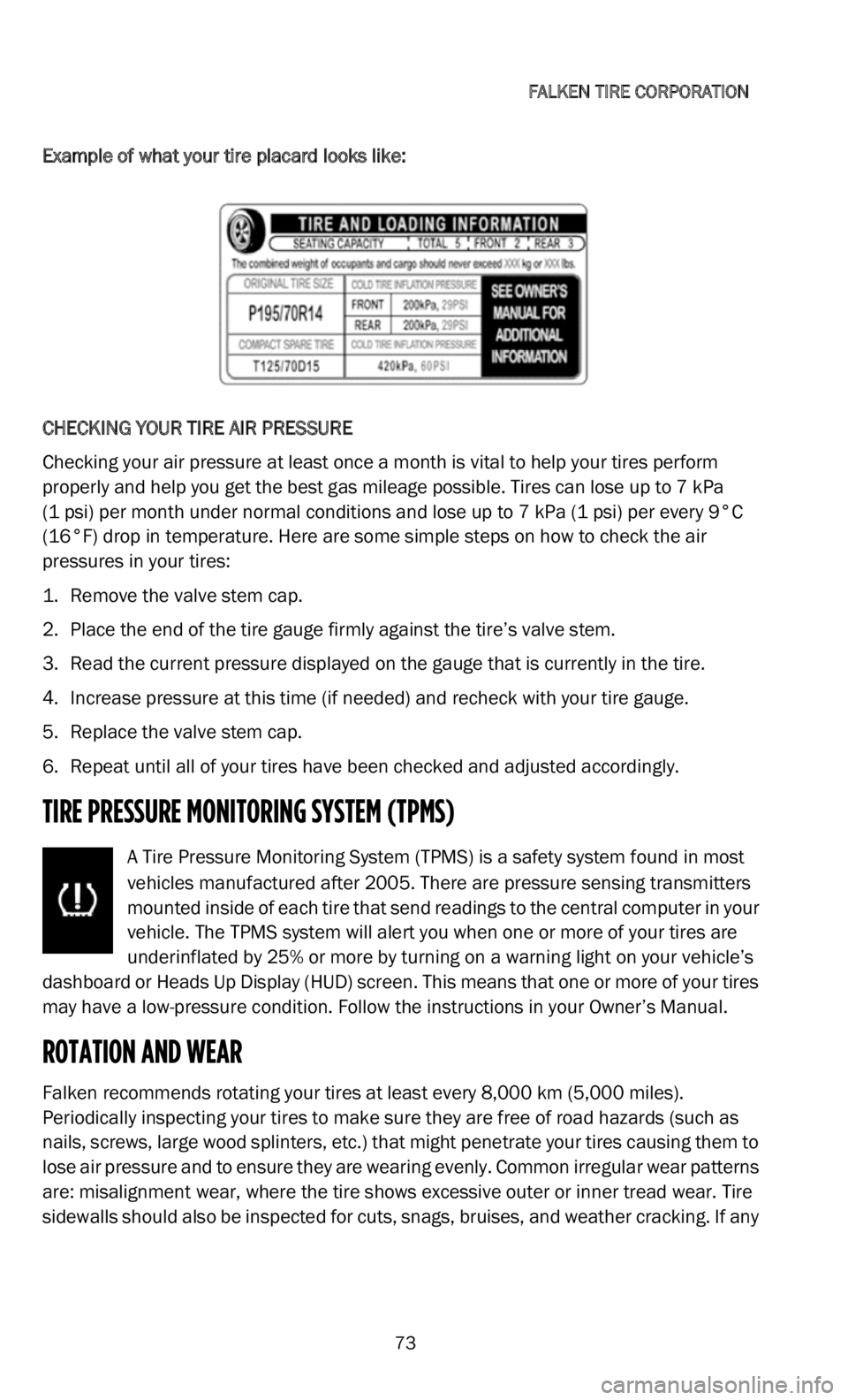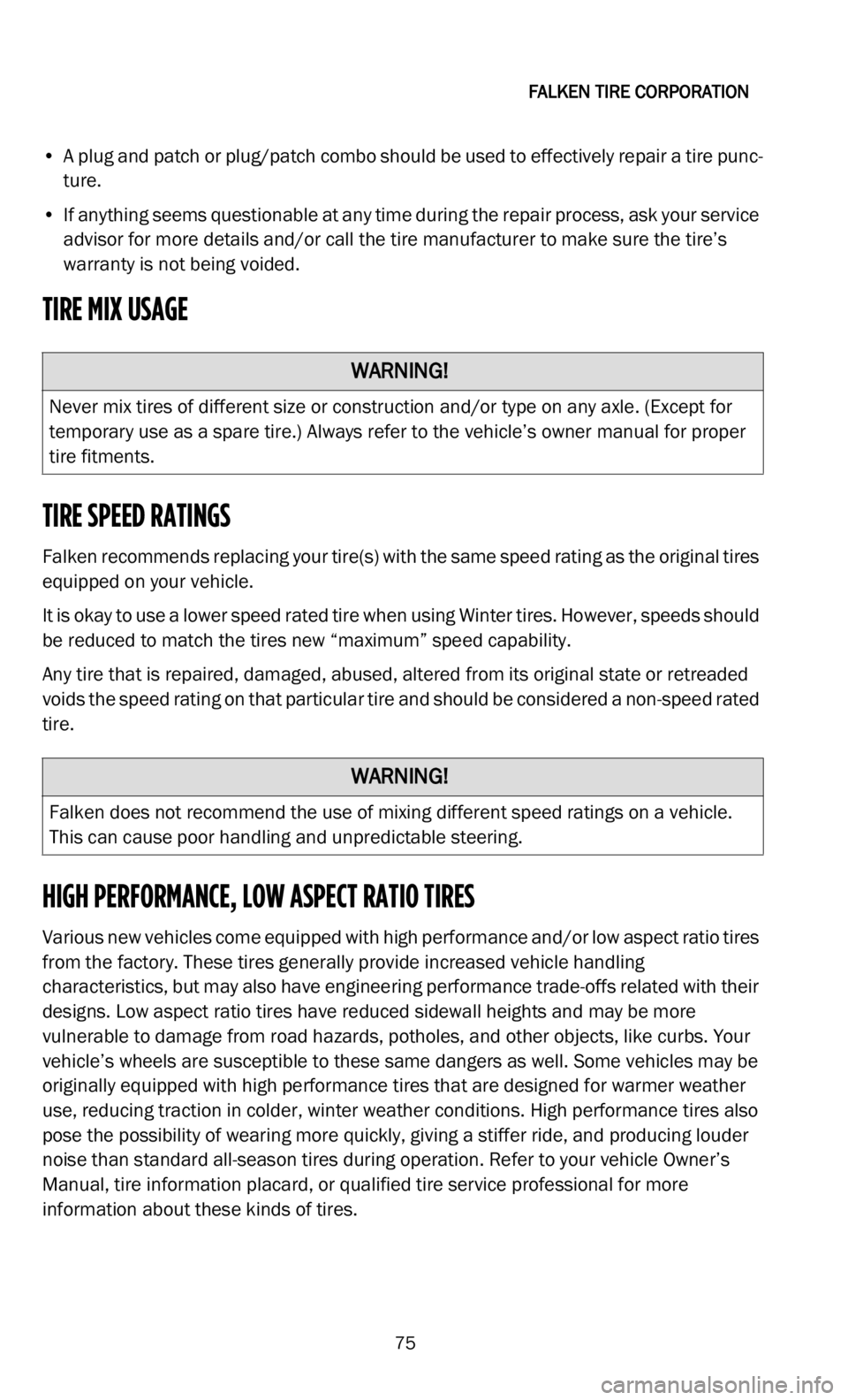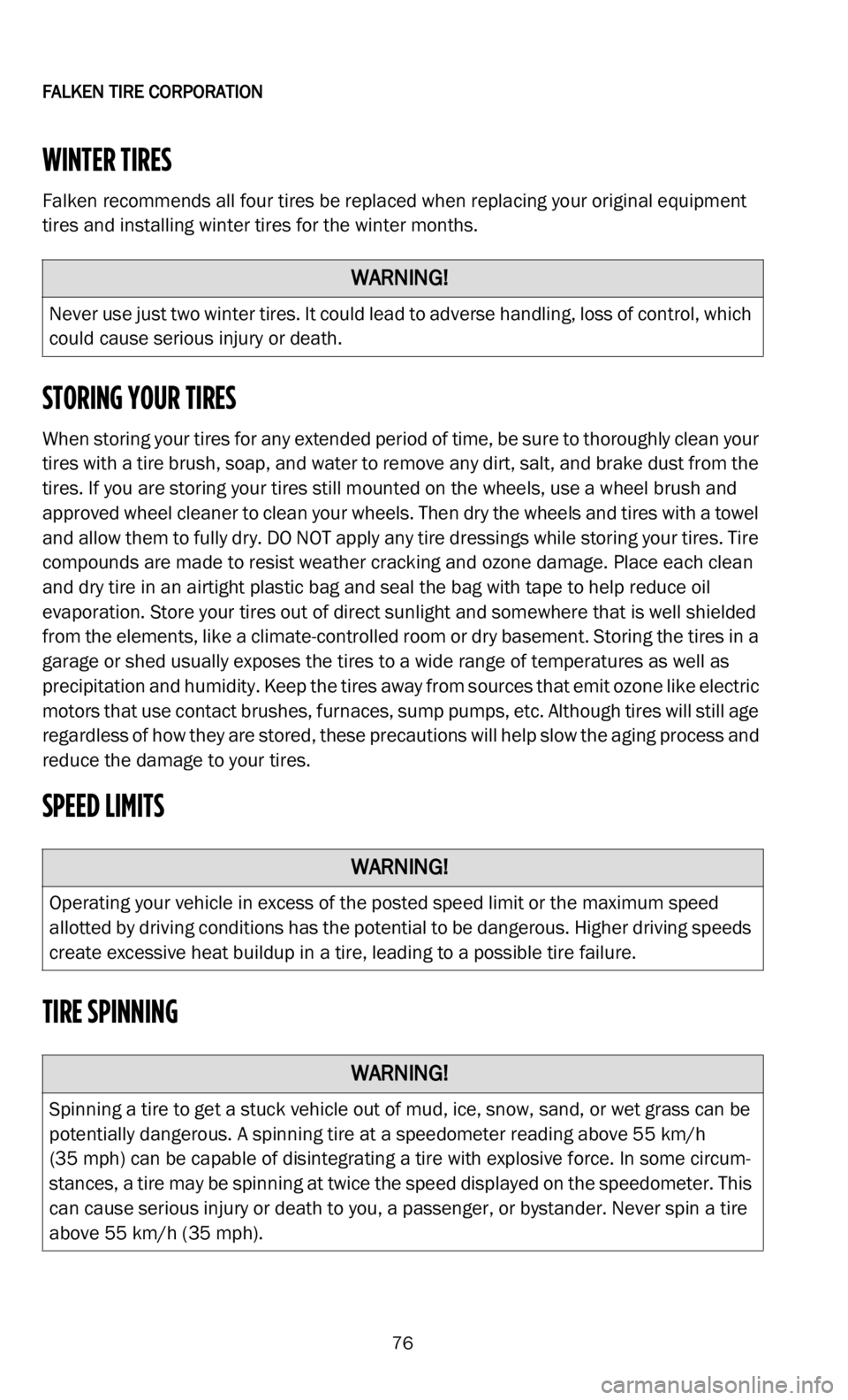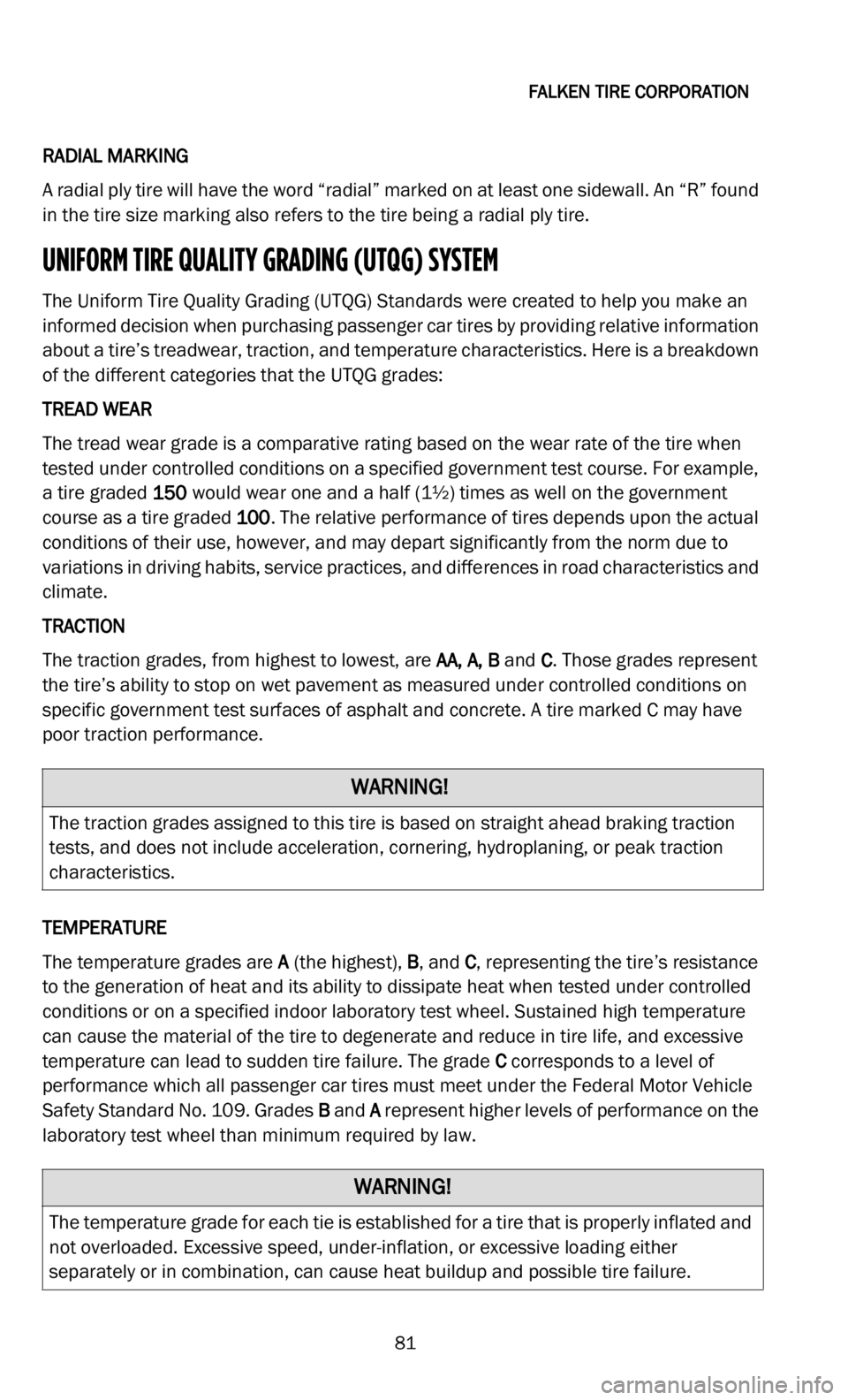warning DODGE DURANGO 2022 Vehicle Warranty
[x] Cancel search | Manufacturer: DODGE, Model Year: 2022, Model line: DURANGO, Model: DODGE DURANGO 2022Pages: 200, PDF Size: 6.72 MB
Page 70 of 200

CONTINENTAL TIRE
69
regardless of mileage or months of service. This includes payment for tire rotation,
alignment, towing, road service, valve stems and tire repairs.
Owner is responsible for maintaining proper tire air pressure and for proper maintenance
o f
the tire.
SAFETY WARNING:
Ignoring any of the safety and information contained in this warranty may result in tire
f a
ilure, causing serious injury or death.
• Tire failure due to underinflation/overloading.
Follow vehicle Owner’s Manual or tire
placard in vehicle for proper inflation and loading.
• Explosion of tire/rim assembly due to improper tire mounting.
Tire mounting/
demounting can be dangerous. It should be performed only by a trained tire specialist
using proper tools and procedures. Prior to tire mounting/demounting, the US Tire
Manufacturers Association (USTMA) wall charts and manuals should be read to obtain
the proper procedures. The failure to follow these procedures may result in faulty posi -
tioning of the tire and/or rim, which may cause the assembly to burst with force suffi -
cient to cause injury or death.
• T
ire failure due to damage.
Inspect your tires frequently for scrapes, bulges, separa -
tions, cuts, snags and other damage from road hazards. Damage from impact can
o c
cur to the inner portions of your tire without being visible to the outside. If you
suspect a tire has been damaged from striking anything unusual in the road, you must
have the tire removed from the rim and inspected both inside and out by a trained tire
specialist. Air loss or unusual tire wear can also be warning signs that a tire may have
internal damage. If you notice these conditions, have your tire inspected by a trained
individual.
• T ire failure due to excessive tire spinning. A
void tire spinning. The centrifugal force
generated by a free-spinning tire/rim assembly may cause a sudden tire explosion
resulting in vehicle damage and/or serious injury or death. Never exceed 35 mph
( 5
5km/h) as indicated on your speedometer when your vehicle is stuck in snow, mud,
or sand and your tire(s) is/are spinning. Use a gentle backward and forward rocking
motion to free your vehicle for continued driving. Never stand or permit anyone else to
stand near or behind a tire spinning while attempting to push a vehicle that is stuck.
SELF SUPPORTING RUNFLAT (SSR) TIRE OWNERS
Continental Tire the Americas, LLC (CTA) does not recommend any repair to or reuse of
punctured Continental SSR tires.
Even a trained tire specialist may be unable to recognize internal structural damage to a
S e
lf Supporting Run-flat (SSR) tire resulting from having been driven in an under inflated
or zero inflation pressure condition. Such damage may not be visible on the surface of
the inner liner or sidewall making it impossible to determine the tire suitability for repair
or reuse. CTA does not recommend any repair to or reuse of Continental SSR tires. You
may visit https://www.continentaltire.com/ or www.continentaltire.ca and select
Customer Care FAQs to obtain additional SSR information.
Page 74 of 200

FALKEN TIRE CORPORATION
73
Example of what your tire placard looks like:
CHECKING YOUR TIRE AIR PRESSURE
Checking your air pressure at least once a month is vital to help your tires perform
p r
operly and help you get the best gas mileage possible. Tires can lose up to 7 kPa
(1 psi) per month under normal conditions and lose up to 7 kPa (1 psi) per every 9°C
( 1
6°F) drop in temperature. Here are some simple steps on how to check the air
pressures in your tires:
1. R emove the valve stem cap.
2
. P lace the end of the tire gauge firmly against the tire’s valve stem.
3
. R ead the current pressure displayed on the gauge that is currently in the tire.
4
. I ncrease pressure at this time (if needed) and recheck with your tire gauge.
5
. R eplace the valve stem cap.
6
. R epeat until all of your tires have been checked and adjusted accordingly.
TIRE PRESSURE MONITORING SYSTEM (TPMS)
A Tire Pressure Monitoring System (TPMS) is a safety system found in most
vehicles manufactured after 2005. There are pressure sensing transmitters
mo
unted inside of each tire that send readings to the central computer in your
vehicle. The TPMS system will alert you when one or more of your tires are
underinflated by 25% or more by turning on a warning light on your vehicle’s
dashboard or Heads Up Display (HUD) screen. This means that one or more of your tires
may have a low-pressure condition. Follow the instructions in your Owner’s Manual.
ROTATION AND WEAR
Falken recommends rotating your tires at least every 8,000 km (5,000 miles).
Pe
riodically inspecting your tires to make sure they are free of road hazards (such as
nails, screws, large wood splinters, etc.) that might penetrate your tires causing them to
lose air pressure and to ensure they are wearing evenly. Common irregular wear patterns
are: misalignment wear, where the tire shows excessive outer or inner tread wear. Tire
sidewalls should also be inspected for cuts, snags, bruises, and weather cracking. If any
Page 76 of 200

FALKEN TIRE CORPORATION
75
• A plug and patch or plug/patch combo should be used to effectively repair a tire punc -
ture.
• I f anything seems questionable at any time during the repair process, ask your service
a
dvisor for more details and/or call the tire manufacturer to make sure the tire’s
warranty is not being voided.
TIRE MIX USAGE
TIRE SPEED RATINGS
Falken recommends replacing your tire(s) with the same speed rating as the original tires
equipped on your vehicle.
It is okay to use a lower speed rated tire when using Winter tires. However, speeds should
b e
reduced to match the tires new “maximum” speed capability.
Any tire that is repaired, damaged, abused, altered from its original state or retreaded
v o
ids the speed rating on that particular tire and should be considered a non-speed rated
tire.
HIGH PERFORMANCE, LOW ASPECT RATIO TIRES
Various new vehicles come equipped with high performance and/or low aspect ratio tires
from the factory. These tires generally provide increased vehicle handling
characteristics, but may also have engineering performance trade-offs related with their
designs. Low aspect ratio tires have reduced sidewall heights and may be more
vulnerable to damage from road hazards, potholes, and other objects, like curbs. Your
vehicle’s wheels are susceptible to these same dangers as well. Some vehicles may be
originally equipped with high performance tires that are designed for warmer weather
use, reducing traction in colder, winter weather conditions. High performance tires also
pose the possibility of wearing more quickly, giving a stiffer ride, and producing louder
noise than standard all-season tires during operation. Refer to your vehicle Owner’s
Manual, tire information placard, or qualified tire service professional for more
information about these kinds of tires.
WARNING!
Never mix tires of different size or construction and/or type on any axle. (Except for
temporary use as a spare tire.) Always refer to the vehicle’s owner manual for proper
tire fitments.
WARNING!
Falken does not recommend the use of mixing different speed ratings on a vehicle.
This can cause poor handling and unpredictable steering.
Page 77 of 200

FALKEN TIRE CORPORATION 76
WINTER TIRES
Falken recommends all four tires be replaced when replacing your original equipment
tires and installing winter tires for the winter months.
STORING YOUR TIRES
When storing your tires for any extended period of time, be sure to thoroughly clean your
tires with a tire brush, soap, and water to remove any dirt, salt, and brake dust from the
tires. If you are storing your tires still mounted on the wheels, use a wheel brush and
approved wheel cleaner to clean your wheels. Then dry the wheels and tires with a towel
and allow them to fully dry. DO NOT apply any tire dressings while storing your tires. Tire
compounds are made to resist weather cracking and ozone damage. Place each clean
and dry tire in an airtight plastic bag and seal the bag with tape to help reduce oil
evaporation. Store your tires out of direct sunlight and somewhere that is well shielded
from the elements, like a climate-controlled room or dry basement. Storing the tires in a
garage or shed usually exposes the tires to a wide range of temperatures as well as
precipitation and humidity. Keep the tires away from sources that emit ozone like electric
motors that use contact brushes, furnaces, sump pumps, etc. Although tires will still age
regardless of how they are stored, these precautions will help slow the aging process and
reduce the damage to your tires.
SPEED LIMITS
TIRE SPINNING
WARNING!
Never use just two winter tires. It could lead to adverse handling, loss of control, which
could cause serious injury or death.
WARNING!
Operating your vehicle in excess of the posted speed limit or the maximum speed
allotted by driving conditions has the potential to be dangerous. Higher driving speeds
create excessive heat buildup in a tire, leading to a possible tire failure.
WARNING!
Spinning a tire to get a stuck vehicle out of mud, ice, snow, sand, or wet grass can be
potentially dangerous. A spinning tire at a speedometer reading above 55 km/h
( 3
5 mph) can be capable of disintegrating a tire with explosive force. In some circum -
stances, a tire may be spinning at twice the speed displayed on the speedometer. This
c a
n cause serious injury or death to you, a passenger, or bystander. Never spin a tire
above 55 km/h (35 mph).
Page 82 of 200

FALKEN TIRE CORPORATION
81
RADIAL MARKING
A radial ply tire will have the word “radial” marked on at least one sidewall. An “R” found
i n
the tire size marking also refers to the tire being a radial ply tire.
UNIFORM TIRE QUALITY GRADING (UTQG) SYSTEM
The Uniform Tire Quality Grading (UTQG) Standards were created to help you make an
informed decision when purchasing passenger car tires by providing relative information
about a tire’s treadwear, traction, and temperature characteristics. Here is a breakdown
of the different categories that the UTQG grades:
TREAD WEAR
The tread wear grade is a comparative rating based on the wear rate of the tire when
te
sted under controlled conditions on a specified government test course. For example,
a tire graded 150 would wear one and a half (1½) times as well on the government
course as a tire graded 100. The relative performance of tires depends upon the actual
conditions of their use, however, and may depart significantly from the norm due to
variations in driving habits, service practices, and differences in road characteristics and
climate.
TRACTION
The traction grades, from highest to lowest, are AA
, A, B and C. Those grades represent
the tire’s ability to stop on wet pavement as measured under controlled conditions on
specific government test surfaces of asphalt and concrete. A tire marked C may have
poor traction performance.
TEMPERATURE
The temperature grades are A
(the highest), B, and C, representing the tire’s resistance
to the generation of heat and its ability to dissipate heat when tested under controlled
conditions or on a specified indoor laboratory test wheel. Sustained high temperature
can cause the material of the tire to degenerate and reduce in tire life, and excessive
temperature can lead to sudden tire failure. The grade C corresponds to a level of
performance which all passenger car tires must meet under the Federal Motor Vehicle
Safety Standard No. 109. Grades B and A represent higher levels of performance on the
laboratory test wheel than minimum required by law.
WARNING!
The traction grades assigned to this tire is based on straight ahead braking traction
tests, and does not include acceleration, cornering, hydroplaning, or peak traction
characteristics.
WARNING!
The temperature grade for each tie is established for a tire that is properly inflated and
not overloaded. Excessive speed, under-inflation, or excessive loading either
separately or in combination, can cause heat buildup and possible tire failure.
Page 88 of 200

87
GENERAL TIRE
LIMITED WARRANTY FOR ORIGINAL EQUIPMENT PASSENGER CAR AND LIGHT TRUCK
TIRES (Including SPECIAL SPARE Tires)
This booklet also includes important safety warnings.
ELIGIBILITY
This Limited Warranty and Adjustment Policy applies to the original owner of new General
brand passenger and light truck (LT) tires that are the new vehicle original equipment
tires bearing the General brand name and Department of Transportation (DOT) Tire
Identification, operated in normal service, and used on the same vehicle on which they
were originally installed according to the vehicle manufacturer’s recommendations.
Tire(s) on any vehicle registered and normally operated outside the United States and
Can
ada are excluded from eligibility under this Limited Warranty and Adjustment Policy.
WHAT IS THE ADJUSTMENT POLICY AND HOW LONG IS IT APPLICABLE?
BASIC COVERAGE:
Eligible Tires are covered by this Limited Warranty and Adjustment Policy for a maximum
of
72 months from the date of purchase, determined by the new vehicle registration date
or
new vehicle sales invoice showing date of purchase.
Where To Go For Warranty Replacement: Co
ntact the vehicle dealer from where you
purchased the vehicle to determine the eligible warranty coverage for your tires and
where to proceed from there.
Free Replacement Period: If
an eligible General brand passenger or light truck tire
becomes unserviceable from a condition other than those listed under Section 3 during
the first 12 months or first 2/32 of an inch (1.6 mm) of tread wear (whichever comes
fi r
st) it will be replaced with a comparable new General brand tire FREE OF CHARGE,
including mounting and balancing. Owner pays all applicable taxes.
Temporary Spare Tires: Th
is Policy also extends to the original owner of the General
brand Temporary Spare Tire that was originally equipped by the vehicle manufacturer as
a temporary spare tire bearing a General Department of Transportation (DOT) serial
number. An eligible Temporary Spare Tire under this Policy must have been operated in
normal service, used on the same vehicle on which they were originally installed
according to the vehicle manufacturer’s recommendations,
This Policy is for a maximum period of 72 months from date of purchase, determined by
th e
new vehicle registration date or new vehicle sales invoice showing date purchased.
If a Temporary Spare Tire becomes unserviceable from a condition other than those
li s
ted in Section 3, during the first 1/32 of an inch (0.8 mm) of tread wear, then it will be
re p
laced with a comparable new General brand Temporary Spare Tire FREE OF CHARGE,
including mounting and balancing. The owner pays all applicable taxes.
After this “Free Replacement Policy” for your Temporary Spare Tire expires, no
ad j
ustment will be made.
Page 90 of 200

GENERAL TIRE
89
• Improper Mounting or Demounting
• Alteration:
Such as, but not limited to, adding a white inlay on black wall, tread
regrooving, tire truing or siping, or adding sealant materials to the tire.
• Weather checking/cracking: Not covered after 48
months from the date of purchase.
• Failure to observe safety and maintenance precautions set forth in the Safety Warning
S
ection.
ATTENTION AUTHORIZED DEALERS:
CTNA RESERVES THE RIGHT TO THE FINAL INSPECTION DECISION FOR ALL RETURNED
TI
RES ON CONDITIONS UNDER THIS SECTION.
THIS LIMITED WARRANTY AND POLICY IS MADE IN LIEU OF ALL OTHER WARRANTIES,
E X
PRESS OR IMPLIED, INCLUDING, BUT NOT LIMITED TO, WARRANTIES OF
MERCHANTABILITY OR FITNESS FOR A PARTICULAR PURPOSE. CTNA EXPRESSLY
DISCLAIMS ALL IMPLIED WARRANTIES, INCLUDING, BUT NOT LIMITED TO, WARRANTIES
OF MERCHANTABILITY OR FITNESS FOR A PARTICULAR PURPOSE. SOME U.S. STATES
AND/OR CANADIAN PROVINCES DO NOT PERMIT SUCH A LIMITATION; FOR THOSE U.S.
STATES AND/OR CANADIAN PROVINCES, ANY IMPLIED WARRANTIES, INCLUDING, BUT
NOT LIMITED TO, ANY WARRANTY OF MERCHANTABILITY OR FITNESS FOR A PARTICULAR
PURPOSE, ARE LIMITED TO THE DURATION OF THIS WRITTEN LIMITED WARRANTY.
SOME U.S. STATES AND/OR CANADIAN PROVINCES DO NOT ALLOW LIMITATIONS ON
THE DURATION OF AN IMPLIED WARRANTY, SO THE ABOVE MAY NOT APPLY TO YOU.
TO THE EXTENT PERMITTED BY LAW, CTNA DISCLAIMS LlABILITY FOR ALL
C O
NSEQUENTIAL AND INCIDENTAL DAMAGES. THE REMEDIES SET FORTH IN THIS
LIMITED WARRANTY ARE THE SOLE AND EXCLUSIVE REMEDIES FOR BREACH OF
WARRANTY. SOME U.S. STATES AND/OR CANADIAN PROVINCES DO NOT ALLOW THE
EXCLUSION OR LIMITATION OF INCIDENTAL OR CONSEQUENTIAL DAMAGES, SO THE
ABOVE LIMITATION OR EXCLUSION MAY NOT APPLY TO YOU. THIS WARRANTY GIVES YOU
SPECIFIC LEGAL RIGHTS, AND YOU MAY ALSO HAVE OTHER RIGHTS WHICH VARY FROM
U.S. STATE TO STATE AND/OR CANADIAN PROVINCE TO PROVINCE.
THIS IS THE ONLY EXPRESS WARRANTY MADE BY CTNA. NO CTNA EMPLOYEE, RETAILER,
O R
DEALER HAS THE AUTHORITY TO MAKE ANY WARRANTY, REPRESENTATION,
PROMISE OR AGREEMENT ON BEHALF OF CTNA EXCEPT AS EXPRESSLY WRITTEN IN
THIS LIMITED WARRANTY AND ADJUSTMENT POLICY.
IN OBSERVANCE OF U.S. FEDERAL LAW, THIS LIMITED WARRANTY AND ADJUSTMENT
P O
LICY HAS BEEN DESIGNATED A “LIMITED WARRANTY”. CTNA DOES NOT INTEND TO
REPRESENT THROUGH THIS LIMITED WARRANTY AND ADJUSTMENT POLICY THAT TIRE
FAILURES CAN OR CANNOT HAPPEN.
CONTINENTAL TIRE NORTH AMERICA’S (CTNA) OBLIGATIONS
Contact the vehicle dealer from where you purchased the vehicle. Your tires may be
covered under the vehicle manufacturer’s limited warranty. If not, this CTNA Policy
applies and replacement of Eligible Tires can be made by any vehicle dealer authorized
to handle General brand tire adjustments or a General brand authorized dealer
Page 91 of 200

GENERAL TIRE
90
(“Authorized Dealer”). CTNA will replace the tire pursuant to the terms of this Limited
Warranty and Adjustment Policy. Tires that are replaced under an adjustment basis
under this Limited Warranty and Adjustment Policy become the property of CTNA.
OWNER’S OBLIGATIONS
To make an eligible claim under this Limited Warranty and Adjustment Policy, the owner
must present a claim with the tire to an authorized dealer. For the nearest authorized
dealer, consult the Yellow Pages, the General brand internet address, or the 800 telephone
numbers shown on the back of this Limited Warranty and Adjustment Policy. Owner must
present new vehicle registration form or new vehicle sales invoice indicating the date of
purchase. Owner will be required to sign the CTNA Limited Warranty Claim Form or dealer
replacement sales receipt.
Owner is responsible for paying all applicable taxes set forth under this Limited Warranty
and
Adjustment Policy. Owner is also responsible for paying local tire disposal fees and any
parts or service regardless of mileage or months of service. This includes payment for tire
rotation, alignment, towing, road service, valve stems and tire repairs. Owner is
responsible for maintaining proper tire air pressure and for proper maintenance of the tire.
SAFETY WARNING:
Ignoring any of the safety and information contained in this limited warranty and
Adjustment Policy may result in tire failure, causing serious injury or death.
• Tire failure due to underinflation/overloading.
Follow vehicle Owner’s Manual or tire
placard in vehicle for proper inflation and loading.
• Explosion of tire/rim assembly due to improper tire mounting.
Tire mounting /
demounting can be dangerous. It should be performed only by a trained tire specialist
using proper tools and procedures. Prior to tire mounting/demounting, the Rubber
Manufacturers Association (RMA) wall charts and manuals should be read to obtain
the proper procedures. The failure to follow these procedures may result in faulty posi -
tioning of the tire and/or rim, which may cause the assembly to burst with force suffi -
cient to cause injury or death.
• T
ire failure due to damage.
Inspect your tires frequently for scrapes, bulges, separations,
cuts, snags and other damage from road hazards. Damage from impact can occur to the
inner portions of your tire without being visible to the outside. If you suspect a tire has
been damaged from striking anything unusual in the road, you must have the tire
removed from the rim and inspected both inside and out by a trained tire specialist. Air
loss or unusual tire wear can also be warning signs that a tire may have internal damage.
If you notice these conditions, have your tire inspected by a trained individual.
• Tire failure due to excessive tire spinning.
Avoid tire spinning. The centrifugal force
generated by a free-spinning tire/rim assembly may cause a sudden tire explosion
resulting in vehicle damage and/or serious injury or death. Never exceed 35 mph
( 5
5 km/h) as indicated on your speedometer when your vehicle is stuck in snow, mud,
o r
sand and your tire(s) is/are spinning. Use a gentle backward and forward rocking
motion to free your vehicle for continued driving. Never stand or permit anyone else to
stand near or behind a tire spinning while attempting to push a vehicle that is stuck.
Page 96 of 200

GOODYEAR® DUNLOP® TIRES
95
INCLUDING WITHOUT LIMITATION ANY WARRANTY OF MERCHANTABILITY OR FITNESS
FOR A PARTICULAR PURPOSE, AND NO OTHER WARRANTY OR REPRESENTATION OF ANY
KIND IS MADE BY GOODYEAR® OR SHALL BE IMPLIED BY LAW.
LIMITATION OF DAMAGES: IN NO EVENT AND UNDER NO CIRCUMSTANCE SHALL
G O
ODYEAR® BE LIABLE TO THE BUYER FOR ANY INDIRECT, SPECIAL, INCIDENTAL,
CONSEQUENTIAL, LOST PROFIT, LOSS OF BUSINESS, LOSS OF GOODWILL OR
REPUTATION, PUNITIVE OR OTHER DAMAGE, COST (INCLUDING FOR REPLACEMENT
TRANSPORTATION), EXPENSE OR LOSS OF ANY KIND. SOME STATES AND PROVINCES
DO NOT ALLOW THE EXCLUSION OR LIMITATION OF INCIDENTAL OR CONSEQUENTIAL
DAMAGES, SO THE ABOVE LIMITATION OR EXCLUSION MAY NOT APPLY TO YOU.
This warranty gives you specific legal rights and you may also have other rights that vary
f r
om state to state or province to province.
HOW DO YOU OBTAIN AN ADJUSTMENT?
1. You must present the tire to be adjusted to an authorized Goodyear® or Dunlop® service facility. Tires replaced on an adjustment basis become the property of The
Goodyear® Tire & Rubber Company or Goodyear® Canada Inc.
2. Y ou must pay for taxes and any additional services you order at the time of adjust -
m
ent plus any additional service that may be unique to your application, e.g., Tire
P r
essure Monitoring System (TPMS).
3. Y ou must submit your claim on an approved claim form supplied by an authorized
G
oodyear® or Dunlop® service facility. The form must be filled out completely and
signed, where you the owner or an authorized agent presented the tire for adjust -
ment. You must go to an authorized Goodyear® or Dunlop® outlet for replacement
t i
res and all warranty service.
SAFETY WARNINGS
Property damage, serious injury or death may result from:
• TIRE FAILURE DUE TO UNDERINFLATION/OVERLOADING/ MISAPPLICATION.
Follow
the vehicle Owner’s Manual or tire placard in vehicle.
• TIRE FAILURE DUE TO IMPACT DAMAGE/IMPROPER MAINTENANCE.
Tires should be
inspected regularly by a qualified technician for signs of damage, such as punctures
or impacts.
• TIRE FAILURE DUE TO IMPROPER REPAIRS. See US Tire Manufactuers Association
(
USTMA) established repair procedures at https://www.ustires.org/ and/or go to
www.goodyear.com for information on proper repair procedures.
• EXPLOSION OF TIRE/RIM ASSEMBLY DUE TO IMPROPER MOUNTING.
Only specially
trained persons should mount tires.
• FAILURE TO MOUNT RADIAL TIRES ON APPROVED RIMS.
• FAILURE TO DEFLATE SINGLE OR DUAL ASSEMBLIES COMPLETELY BEFORE
D
EMOUNTING.
Page 97 of 200

GOODYEAR® DUNLOP® TIRES
96
•TIRE SPINNING. On slippery surfaces such as snow, mud, ice, etc., do not spin tires in
excess of 35 mph (55 km/h), as indicated on the speedometer.
• EXCESSIVE WHEEL SPINNING.
This can also result in tire disintegration or axle failure.
TIRE CARE AND MAINTENANCE GUIDE
The easiest way to help ensure satisfactory mileage and performance from your
Goodyear® or Dunlop® tires is to give them a simple but frequent (at least monthly)
inspection for proper inflation, even tread wear and the presence of any damage.
DO MAINTAIN PROPER INFLATION PRESSURE IN YOUR TIRES
Proper inflation pressure is necessary for optimum tire performance, safety and fuel
economy. Check inflation pressures at least once a month and before long trips. Use an
accurate tire pressure gauge. Always check pressures when the tires are cold (when the
vehicle has been driven less than one mile). If you must check inflation when the tires
are hot, add 4 psi (27 kPa) to the recommended cold inflation pressure. It is difficult to
tell just by looking at radial tires whether they are underinflated.*
Furthermore, when operating a vehicle equipped with radial tires, it is difficult to notice
wh
en a tire has gone flat or nearly flat since the “feel” of the vehicle does not change
significantly.
*Evidence of air loss or repeated underinflation always requires expert inspection to
d e
termine the source of leakage and tire removal to determine repairability. To avoid
injury, NEVER attempt to reinflate a tire that has been run severely underinflated.
Progressive air loss may result from punctures, cuts, curbing, impacts or partial bead
unseating. Some fitment causes for air loss are (1) incomplete bead seating, (2) bead
tearing caused by a machine tool due to insufficient lubrication or improper adjustment.
Leaking valve core or rubber valve components should be replaced when problems are
detected and whenever tires are replaced.
WARNING!
Vehicle handling, traction, ride comfort and other performance parameters may be
significantly affected by a change in tire size or type. Before replacing tires, always
consult and follow the vehicle Owner’s Manual because some vehicle manufacturers
prohibit changing tire size. When selecting tires that are different from the original
equipment size make certain:
• The tires have adequate load-carrying capacity based on the vehicle placard.
•
The tires have sufficient inflation pressure to carry the load.
•
There is proper clearance with no interference points between the tire and vehicle.
T
he consumer must be aware to always drive safely and obey all traffic laws. Avoid
s u
dden, sharp turns or aggressive lane changes. Failure to follow any of these
warnings may result in loss of control of the vehicle, leading to an accident and
serious injury or death.